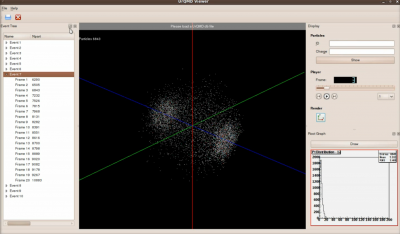HAG
From HP-SEE Wiki
(→General Information) |
(→Usage Example) |
||
| Line 46: | Line 46: | ||
== Usage Example == | == Usage Example == | ||
| - | + | ||
| + | [[File:UrQMDViewer_screenshot.png|thumb|400px|upright|alt=Application main window| Application main interface. On left side is the event tree. On center the 3D visualisation of the interaction(Au-Au at sqrt(sNN )=200GeV ). On right side is the evolution PT distribution over all particles in real-time. Also, at the top right side is the particle filter.]] | ||
| + | |||
| + | HAG allows the user to visualise in 3D the particles generated by UrQMD(Ultra relativistic Quantum Molecular Dynamics) simulations and run a variety of algorithms on the simulation data. The increase GPU (Graphical Processor Unit) performance makes possible both the analysis of data and also the real-time visualisation of the interaction. | ||
| + | |||
| + | As a front-end to the user, the application uses Qt4 libraries for GUI. The input data, obtained from a SQLite3 database file, is fetched and loaded on the graphic device. After this, the data is processed on GPU using CUDA (Compute Unified Device Architecture). The processed data is output in a OpenGL (Open Graphics Library) viewport and in ROOT's graphs or histograms. Using widgets, one can select/filter events, frames or particles that are going to be processed. | ||
| + | |||
| + | Also, another feature is to render all frames in an event continually, such that one sees the evolution of particles as a fluid animation. Just | ||
| + | like movie player, with buttons to play/pause or go forward, backward, these features are a very important in the educational process of students and young researchers. | ||
== Publications == | == Publications == | ||
* ... | * ... | ||
* ... | * ... | ||
Revision as of 10:26, 4 July 2011
Contents |
General Information
- Application's name: High energy physics Algorithms on GPU
- Virtual Research Community: Computational Physics
- Scientific contact: Mihai Niculescu, mihai@spacescience.ro
- Technical contact: Mihai Niculescu, mihai@spacescience.ro
- Developers: High Energy Astrophysics and Advanced Tehnologies, Institute of Space Sciences, Romania
Faculty of Physics, University of Bucharest, Romania
- Web site: http://tobefilledin/
Short Description
HAG - High energy physics Algorithms on GPU - goal is to implement common algorithms used in the study of heavy ions nuclear collisions. More specifically, some algorithms for nuclear flow studies are going to be implemented.
Problems Solved
The most important goal of the heavy-ion physics in the ultra-relativistic energy domain is the search for the phase transition between hadronic matter and the quark-gluon plasma (QGP). This new state of matter is believed to be created at approximate 1 microsecond after the Big Bang. To describe this state of nuclear matter it is necessary to analyze a huge volume of information of physical observables characterizing various emitted particles in ultra relativistic nuclear collisions. The time taken to analyze the data and to obtain fast and reliable results depends on high performance computing. Most common solution to solve this problem is to use large arrays of computer clusters such GRID or GRID-like computing solutions or with local parallel computing facilities. During the last a new technology has emerge in the parallel processing field. This technology allows the processing data to be done on graphic processor. The application computes several interesting observables for heavy-ion physics using the GPUs.
Implemented algorithms for studying nuclear flow and the possibility to visualise data in real time make this application a great tool in research and with possibilities in education.
Thus, main problems solved by this application:
- cutting short the time taken to analyse data
- presenting a tool useful for young students who want to learn more about heavy ion nuclear collisions.
Scientific and Social Impact
Because of the application runs on GPU allows one to make online analysis and see in real time the way parameters change. The possibility to visualize the 3D evolution of the nuclear interaction may prove as an useful tool in education, where graduate students will use a very fast and easy tool for analysis of experimental and simulated data.
Collaborations and Beneficiaries
Upon completion, HAG is going to be a great software tool useful for HEP researchers from Institute of Space Sciences, but it will also benefit Faculty of Physics, University of Bucharest.
Technical Features and HP-SEE Implementation
- Primary programming language: C++
- Parallel programming paradigm: SIMT - Single Instruction Multiple Threads (CUDA with C)
- Main parallel code: C++
- Pre/post processing code: C++
- Application tools and libraries: Qt, CUDA, ROOT framework
- Number of cores required: 4x480 GPUs, 32 CPUs
- Minimum RAM/core required: 1.5GB/video card, 2GB/core
- Storage space during a single run: 4TB
- Long-term data storage: 50TB
Usage Example
HAG allows the user to visualise in 3D the particles generated by UrQMD(Ultra relativistic Quantum Molecular Dynamics) simulations and run a variety of algorithms on the simulation data. The increase GPU (Graphical Processor Unit) performance makes possible both the analysis of data and also the real-time visualisation of the interaction.
As a front-end to the user, the application uses Qt4 libraries for GUI. The input data, obtained from a SQLite3 database file, is fetched and loaded on the graphic device. After this, the data is processed on GPU using CUDA (Compute Unified Device Architecture). The processed data is output in a OpenGL (Open Graphics Library) viewport and in ROOT's graphs or histograms. Using widgets, one can select/filter events, frames or particles that are going to be processed.
Also, another feature is to render all frames in an event continually, such that one sees the evolution of particles as a fluid animation. Just like movie player, with buttons to play/pause or go forward, backward, these features are a very important in the educational process of students and young researchers.
Publications
- ...
- ...
